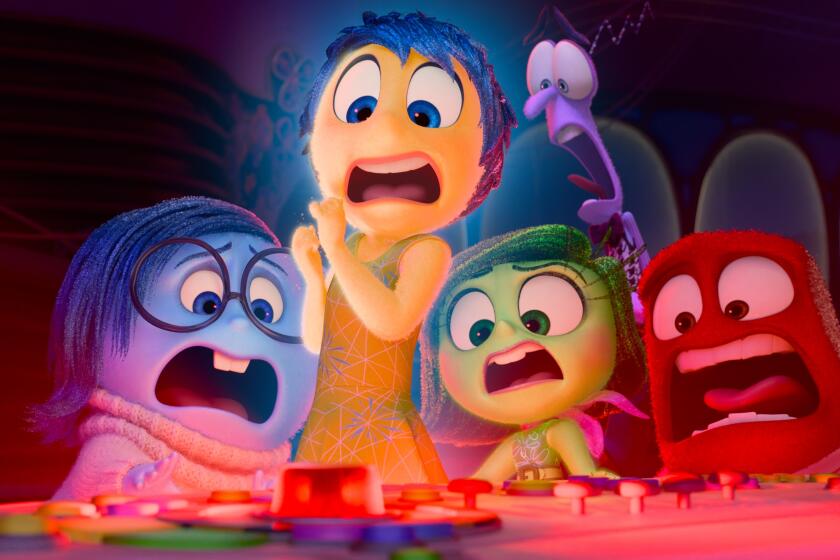Inland Empire cities were once ‘in’ with Hollywood for movie previews
Riverside. Pomona. San Bernardino.
You probably don’t think of these cities as Hollywood power players.
But flash back some 70 years ago, and it was a different story.
From the 1930s to the 1950s, major studios used those locations to screen test some of their biggest movies, including “Gone With the Wind,” “King Kong” and “Snow White and the Seven Dwarfs.”
Movie executives would trek out to these hinterlands — far from the glamorous coast — show their films and ask audiences to fill out preview questionnaires. They used the feedback to make final cuts to the films. Even the stars, curious to see what the public thought of their films, would make occasional appearances.
What made these locations so popular with the film industry?
Pomona and Riverside are on the road to Palm Springs, which was then a playground of the movie crowd. Studio execs could screen a film one evening and head out to the desert for some rest and relaxation afterward, said John Clifford, president of the Friends of the Pomona Fox, a nonprofit group dedicated to the preservation of the city’s historic theater.
The inland cities possessed desirable demographics too. Studios wanted to see how their movies would play in the heartland of American rather than in Los Angeles, which was top heavy with industry folk. These agricultural communities “were as Peoria as you could get without actually going to Peoria,” Clifford said.
All three towns had ideal venues: state-of-the art theaters that were part of the Fox chain. The Fox in San Bernardino opened in 1928, the Riverside Fox in 1929 and the Pomona Fox in 1931.
The Pomona theater in fact, had so many test screenings — up to three a week, according to Clifford — that it was immortalized in a line from the 1950 movie “Sunset Boulevard.” When Norma Desmond, played by Gloria Swanson, tells Joe Gillis (William Holden) about her comeback script, Gillis replies: “They’ll love it in Pomona.”
But audiences didn’t always love everything they saw. After a screening of the 1939 classic “The Wizard of Oz,” the Pomona audience found a reprise of “Over the Rainbow” that Dorothy (Judy Garland) sang while imprisoned in the Wicked Witch of the West’s castle overwrought and affected, according to Clifford. The producers later axed the “Rainbow” reprise.
And moviegoers gave a rough cut of Orson Welles’ 1942 “The Magnificent Ambersons” such poor reviews that the producers took the film away from Welles and made the final cut themselves, Clifford said.
The test audiences’ reaction couldn’t always be taken at face value, however. During the preview of the 1937 “Snow White and the Seven Dwarfs,” half the audience walked out midway through the show. The producers were sure it meant the film was a disaster, “until they learned that someone had made a fruit frost warning, and everyone had to get out to light the smudge pots [to prevent a freeze] in the orange groves,” Clifford said.
Secrecy was another hallmark of some previews.
Although film titles were usually advertised, some were kept under wraps to keep out reporters and curious industry types who could taint the previewing process.
Perhaps the biggest sneak preview of all was Sept. 9, 1939. Moviegoers who entered the Fox in Riverside that day to watch a double feature of “Hawaiian Nights” and “Beau Geste” had no idea that they were about to preview the epic drama “Gone With the Wind.”
The screening was so hush-hush that even the movie’s producer, David. O. Selznick, wasn’t informed of the location, lest he blurt it out to his friends, according to Ronald Haver’s book “David O. Selznick’s Hollywood.” Film editor Hal Kern, who was in charge of the preview, had a chauffeur ferry the producer; his wife, Irene Mayer Selznick; and investor Jock Whitney to Riverside without telling them where the car was headed.
At the end of the first feature, “Hawaiian Nights,” it was announced that a preview would be shown, but the title still wasn’t revealed. Members of the audience were told that they could leave before the screening but that once the movie started, they would not be readmitted and would not be allowed to make phone calls. The theater was then sealed.
When the title flashed across the screen, the crowd stood up and cheered. They’d heard about the making of the film, and now they were the first to see it. When the final credits rolled four hours and 25 minutes later (the film was later cut to under four hours), the crowd gave another ovation.
The Riversiders were dead on with their enthusiastic approval: “Gone With the Wind” went on to win eight Oscars, including best director and best picture.
In the mid- to late 1950s, as the cities grew and lost their small-town atmospheres, they fell out of favor with studios as preview locations, Clifford said. The theaters also began to lose their audiences about the same time because of the growing popularity of drive-ins.
Today, however, the theaters are once again going strong. The San Bernardino theater, now the California Theatre of the Performing Arts, hosts a wide variety of performances, including musicals, plays and concerts. The Fox Theater Pomona and the Riverside theater, now called the Fox Performing Arts Center, have recently been renovated and reopened after years of neglect and disrepair.
On tap this August at the Fox Performing Arts Center: “Gone With the Wind.” This time however, the theater won’t be sealed.
More to Read
Only good movies
Get the Indie Focus newsletter, Mark Olsen's weekly guide to the world of cinema.
You may occasionally receive promotional content from the Los Angeles Times.









